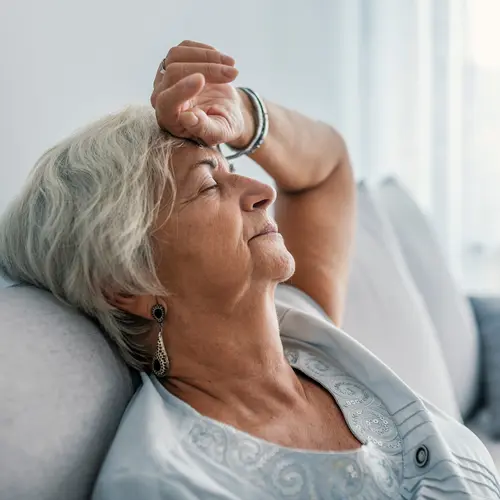Quieting Your Mind When You Have Multiple Myeloma

Hide Video Transcript
Video Transcript
[MUSIC PLAYING] ANGELA GODOY:Living with a chronic illness, you can ruminate and start to think about when the other shoe is going to drop. So if I go into a yoga practice, I'm able to not focus so much on those thoughts. I had been suffering with leg pain for about five or six months.
I went to get out of bed one day and I couldn't stand on my leg. I was screaming. I went to the doctor through biopsies, MRIs, and bloodwork. It was finally a confirmation it was multiple myeloma. I didn't know what that was. I never heard of it. I didn't know anybody that had it. They explained it as kind of like a cousin of a leukemia, because that is also a blood cancer.
So that was like I was in mess. It was very difficult. It was a lot of anxiety, a lot of sleepless nights. I started treatment in July of 2017. I went for a stem cell transplant. Multiple myeloma is incurable. But after the stem cell transplant, I did receive a stringent complete response to therapy. So it's considered a remission.
Once I started trying to work out after my stem cell transplant, I realized that this is going to be a new experience, this is going to be different this time. I don't have that stamina. I have to accept that I can walk, I can hide, I can do things. So it's definitely more of a blessing because now I get to work out. It could have been a completely different place.
Living with multiple myeloma, you get a lot of aches and pains, and being able to distinguish which of these aches and pains are maybe something that I should pay attention to and bring up to my doctor. And yoga actually helps me with that, because it gives me time to quiet my mind, quiet my body, really hear how my body feels.
That's been really helpful to me, especially right now because I'm doing a lot of testing again workup for coming out of remission. So I'm experiencing a lot, a lot of anxiety. So the breath work is really even more so important.
I think the hardest part for me was when I was in a wheelchair. I'm a mom of three children and I was used to doing everything for everybody. It would have been impossible to do all the things that I needed to do if it wasn't for family and friends. And then, of course, support groups.
Support groups are excellent because then you're able to really, really get good advice on how to handle things. And people that understand you is really helpful and has made a huge difference. A lot of times, I volunteer with helping younger diagnosed patients what they're looking at expecting, what treatment looks like.
The main advice that I give them is to continue living to not give up, because there's been so many advances in myeloma lately that people are living longer. It's not necessarily a death sentence anymore. It's becoming more of a chronic illness.
I think that we should expect to live a long life with myeloma. I think we should hope. I forward plan, but I live one day at a time. I'm putting good things on my calendar. Family reunion coming up in May. The more new experiences I can have in life means that I'm living. I continue to plan for those new experiences.
[MUSIC PLAYING]
I went to get out of bed one day and I couldn't stand on my leg. I was screaming. I went to the doctor through biopsies, MRIs, and bloodwork. It was finally a confirmation it was multiple myeloma. I didn't know what that was. I never heard of it. I didn't know anybody that had it. They explained it as kind of like a cousin of a leukemia, because that is also a blood cancer.
So that was like I was in mess. It was very difficult. It was a lot of anxiety, a lot of sleepless nights. I started treatment in July of 2017. I went for a stem cell transplant. Multiple myeloma is incurable. But after the stem cell transplant, I did receive a stringent complete response to therapy. So it's considered a remission.
Once I started trying to work out after my stem cell transplant, I realized that this is going to be a new experience, this is going to be different this time. I don't have that stamina. I have to accept that I can walk, I can hide, I can do things. So it's definitely more of a blessing because now I get to work out. It could have been a completely different place.
Living with multiple myeloma, you get a lot of aches and pains, and being able to distinguish which of these aches and pains are maybe something that I should pay attention to and bring up to my doctor. And yoga actually helps me with that, because it gives me time to quiet my mind, quiet my body, really hear how my body feels.
That's been really helpful to me, especially right now because I'm doing a lot of testing again workup for coming out of remission. So I'm experiencing a lot, a lot of anxiety. So the breath work is really even more so important.
I think the hardest part for me was when I was in a wheelchair. I'm a mom of three children and I was used to doing everything for everybody. It would have been impossible to do all the things that I needed to do if it wasn't for family and friends. And then, of course, support groups.
Support groups are excellent because then you're able to really, really get good advice on how to handle things. And people that understand you is really helpful and has made a huge difference. A lot of times, I volunteer with helping younger diagnosed patients what they're looking at expecting, what treatment looks like.
The main advice that I give them is to continue living to not give up, because there's been so many advances in myeloma lately that people are living longer. It's not necessarily a death sentence anymore. It's becoming more of a chronic illness.
I think that we should expect to live a long life with myeloma. I think we should hope. I forward plan, but I live one day at a time. I'm putting good things on my calendar. Family reunion coming up in May. The more new experiences I can have in life means that I'm living. I continue to plan for those new experiences.
[MUSIC PLAYING]
